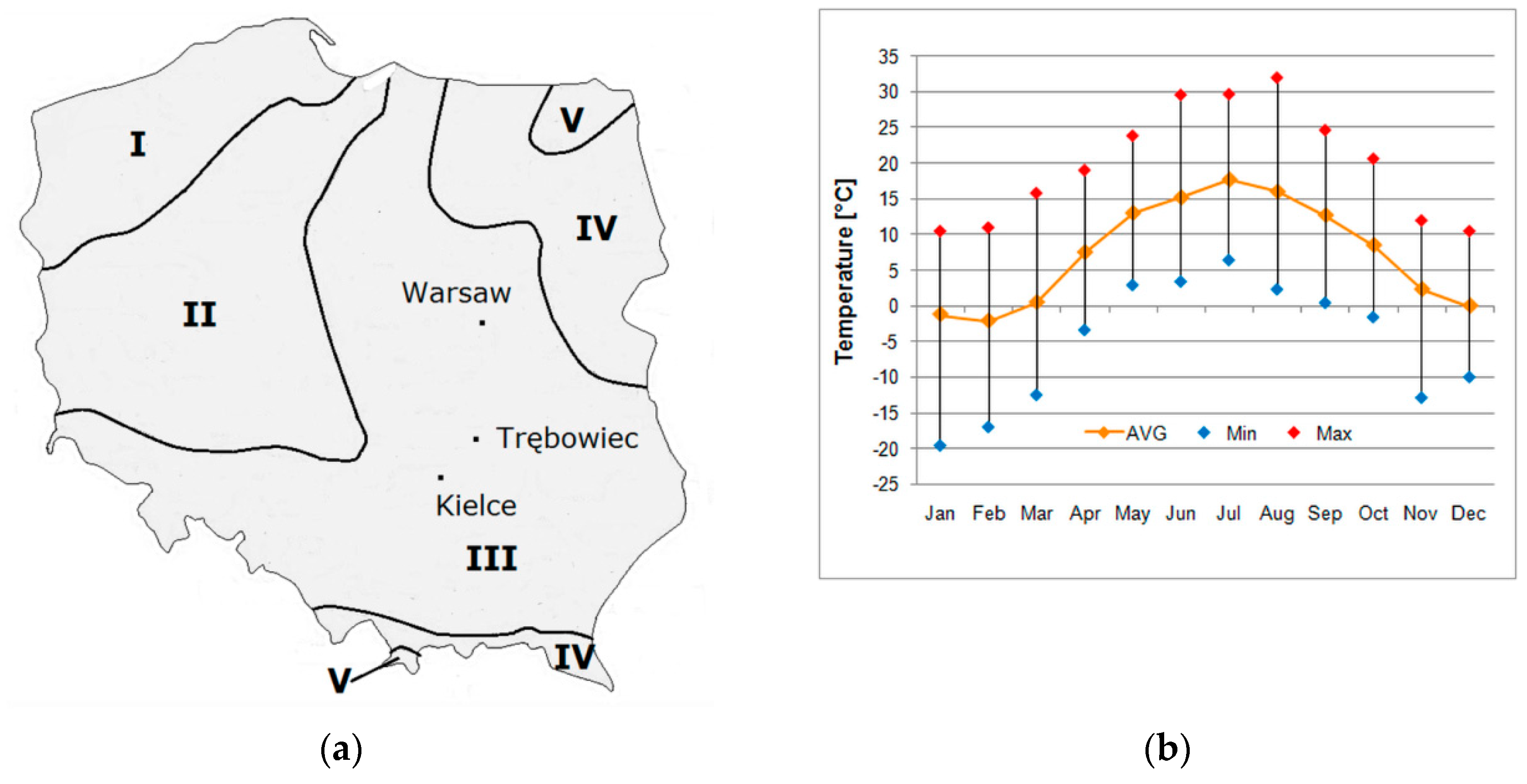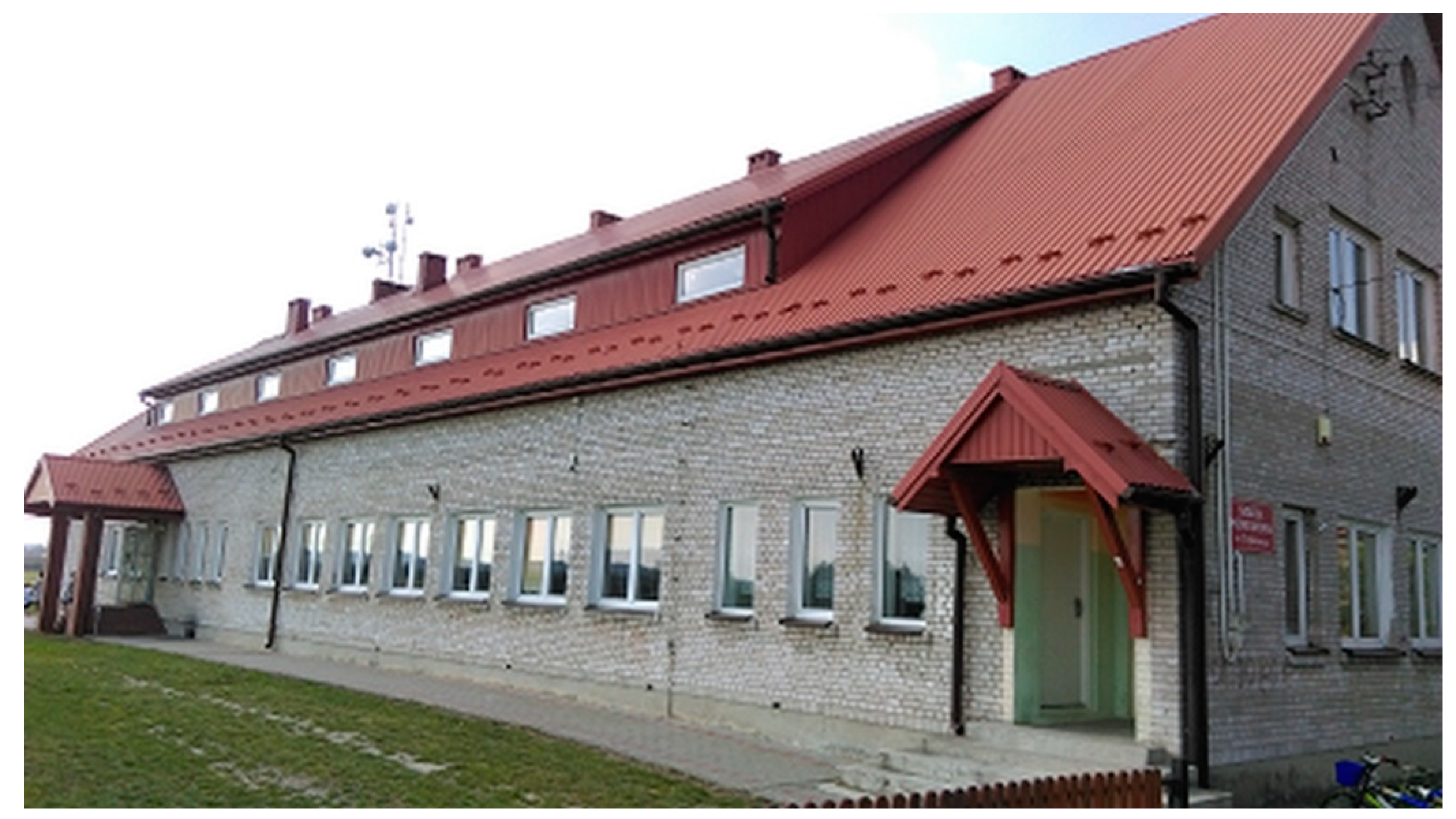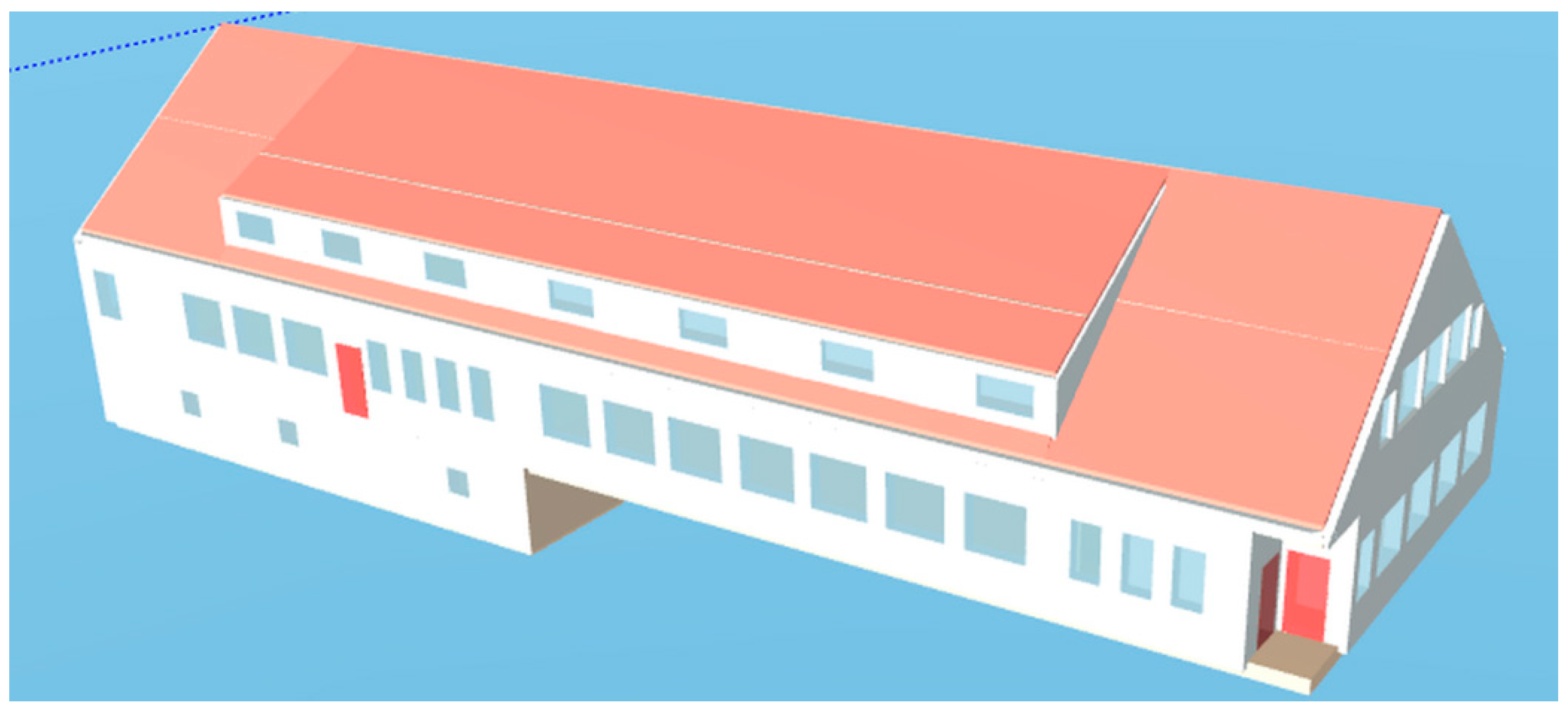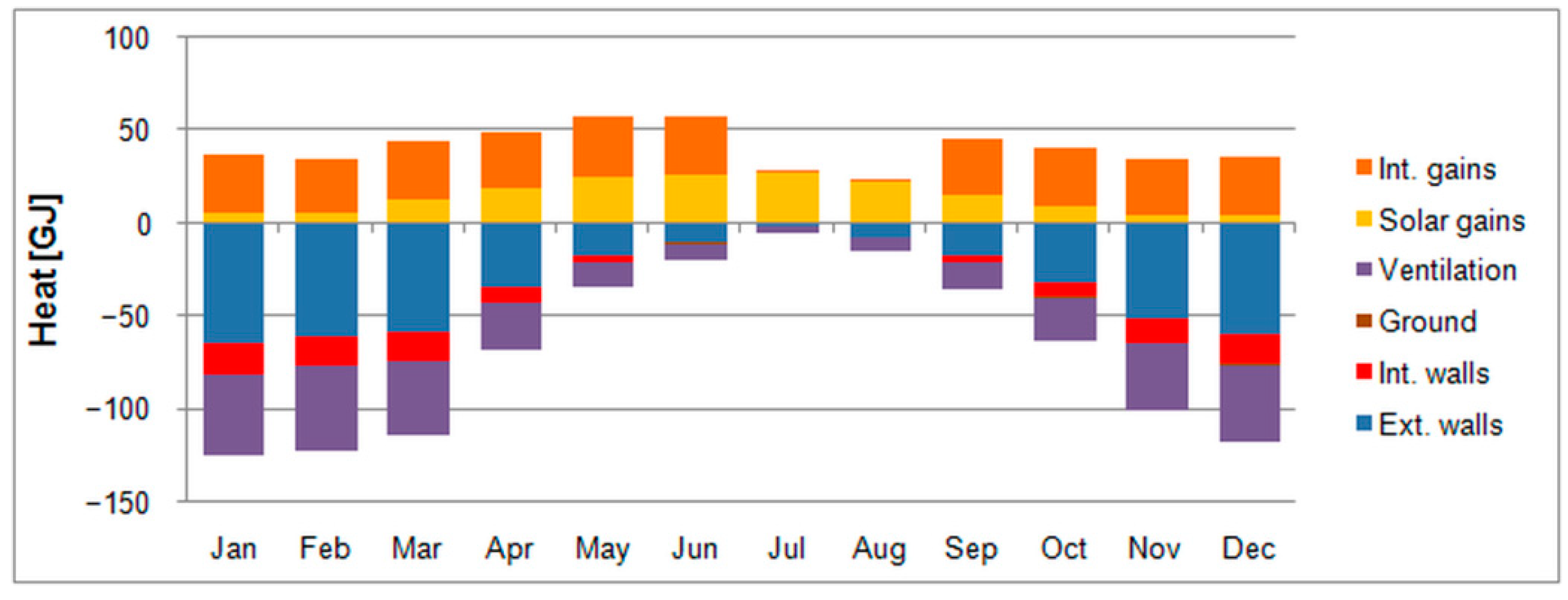1. Introduction
Buildings in Poland are responsible for over 30% of the total energy consumption. Because of the rising energy prices and environmental pollution since the end of 1980s, energy conservation emerged as one of the most important economic and policy issues. Numerous efficiency-related law regulations and support schemes have been introduced for these purposes [
1,
2,
3,
4,
5]. In 1998, the Thermal Modernization Law was introduced [
6] and the Thermal Modernization Fund was put into service [
7]. To receive financial support, an energy audit was required. In the audit, an assessment of the technical condition of a building and heat source had to be performed, and the most advantageous modernization solution for an investor, including costs of its implementation, calculation of the level of anticipated savings, and the simple payback time (SPBT), had to be indicated. If required energy savings were achieved, based on audit recommendations, an optimal project was chosen for the implementation.
Because Poland is the heating-dominated country [
8,
9,
10] at the beginning the most important issue was thermal modernization [
11,
12] mainly involving envelope insulation and new plastic PVC windows. In practice, energy auditors commonly did not take into account thermal comfort issues [
13], focusing only on assuming standard requirements in auditing calculations. Moreover, residents, to lower their heating bills during the heating season, commonly minimized cooling of flats by external air infiltration installing cheap airtight windows, without trickle vents, reducing the exchange of used and fresh air and moisture removal [
14]. Lack of awareness and higher costs of windows with trickle vents were indicated [
15] as the main reasons for the deterioration of microclimatic conditions in apartments. Thus, special attention was required during the design and construction process [
16] as well as monitoring during everyday use. Despite these problems, that scheme resulted in a significant reduction of heating energy [
8,
17,
18,
19] and profited over 45,000 buildings, from which over 95% were multi-family buildings [
9,
20], increasing their market value [
21]. However, there is still not modernized significant part of the building stock in Poland [
22,
23]. Of these, educational buildings are of particular importance for several reasons. Primary and secondary schools in Poland are run by local governments [
24,
25]. They are interested in reducing the operation costs of schools significantly, dependent on energy consumption for heating and lighting. The second problem comes from the technical conditions of buildings. Between 1954 and 1979, there were built in Poland 17.9 thousand (46%) educational buildings, for a total of 38.9 thousand estimated in 2010 [
26]. Their heating demand is relatively high due to the liberal requirements of thermal protection of buildings at that time [
5]. Recent national evaluation [
20] indicates that 60% of educational buildings have improved energy performance. Therefore, a significant number of them still require modernization.
Because energy consumption in schools depends on many technical, operational, and organizational factors [
27], the proper choice of criteria used to assess the optimal variant of a modernization project is a very complex task. Nevertheless, building codes simplify this issue, providing energy-effectiveness requirements clearly and coherently [
28]. Their renovation was willingly taken in Poland, especially in cases of very energy-consuming objects, because of favorable financial support and relatively short calculated payback time of the investment [
29].
Numerous examples of thermal modernizations of educational buildings in Poland have been presented recently [
30,
31,
32,
33,
34,
35,
36,
37,
38], but economic evaluations were very simple and limited to SPBT or operation costs calculations. The energetic effect was in the foreground, but not linked to the investment cost and its projected lifetime.
On the other hand, also many authors have presented more complex methods that require complicated calculations or dedicated computer programs. Among different indicators and assessment methods there were used Net Present Value (NPV) [
39], global cost [
40], macroeconomic and a financial cost [
41], multi-objective optimization [
40], or life cycle assessment (LCA) [
42,
43,
44]. These comprehensive approaches differ from those adopted in Polish regulations [
45], but the general direction is the same-selection of the measure with the lowest SPBT to choose optimal variant of investment.
Analyses of environmental effects were limited mainly to CO
2 emissions [
46,
47,
48]. However, this is too simplistic when it comes to burning fossil fuels, especially for fine coal or other poor quality fuels, burnt in old and inefficient boilers [
49,
50,
51].
In recent years, new regulations and standards regarding energy consumption in newly built and rebuilt buildings have been introduced in Poland [
1,
5,
19,
22,
52]. According to formal requirements, SPBT is used to select the optimal variant of modernization. In general, thermal modernizations usually consist of several parts which differ in resulting energy savings, investment costs, and SPBT [
29]. However, it is the final result of the whole project in terms of reducing energy consumption that is the most important and is the basis for its evaluation. Sometimes some long payback investments must be made to achieve the desired final result.
Three important observations emerge from the presented review. The first is a significant number of school buildings over 40 years old requiring modernization to improve their energy efficiency. The second concerns the profitability assessment of planned modernizations, taking into account the age of the buildings, their payback time, and durability. A more detailed analysis of the environmental effects should also be carried out to obtain a more complete picture of the effects of the investment.
This paper aims to fill this gap coherently presenting in detail the abovementioned issues, by providing a complete description of the completed thermal modernization investment, starting from pre-investment conditions, through energy audit and investment design to the finished project.
In the next section, legal regulations related to energy auditing of buildings in Poland are briefly described, and the procedure to select the optimal variant of the modernization investment is given in detail. Then the case school building is presented, including its energy audit and detailed evaluation of energy, economic, and environmental effects of the completed modernization investment. Then final remarks are given.
2. Legal Environment for Thermal Modernization of Buildings in Poland
Thermal modernization requires expenses for its implementation. Many building owners may not complete the necessary retrofits without additional financial support. This issue is included in several legal acts, as follows:
Act of 21 November 2008 on supporting thermo-modernization and renovation (Journal of Laws of 2008, No. 223, item 1459) [
53].
Regulation of the Minister of Infrastructure on the detailed scope and form of the energy audit and part of the renovation audit, audit card templates, as well as algorithms for assessing the profitability of a thermo-modernization project [
54].
Regulation of the Minister of Infrastructure and Development on the methodology for determining the energy performance of a building or part of a building and energy performance certificates [
55].
Ordinance of the Minister of Infrastructure on technical conditions to be met by buildings and their location [
56].
Regulation of the Minister of Economy on the detailed scope and method of preparing an energy efficiency audit, the template of an energy efficiency audit card, and methods of calculating energy savings [
57].
Act on supporting thermo-modernization and renovation specifies the rules of financing them from the Thermo-Modernization and Renovation Fund [
58,
59,
60]. It defines thermo-modernization projects as follows:
- (a)
The improvement resulting in a reduction in the demand for energy supplied for heating and/or domestic water heating in residential and public utility buildings,
- (b)
An improvement resulting in a reduction of energy losses in local heating networks and supplying them local heat sources for abovementioned objects, if they the energy requirements specified in other regulations,
- (c)
The realization of a network connection to a centralized heat source, in connection with the liquidation of a local heat source,
- (d)
Total or partial conversion of energy sources to renewable sources or the use of high-efficiency cogeneration.
An investor, carrying out one of the abovementioned tasks, may receive thermo-modernization premium as a payoff loan. It is granted in the following amounts:
16% of the project costs,
21% of the project costs-in the case of when, along with the implementation of the thermal modernization project, a micro-installation of a renewable energy source with a maximum capacity of at least 1 kW in a residential single-family building or 6 kW in other buildings.
The condition for receiving the premium is an energy audit, performed following the regulation [
54]. In this audit, the profitability of a thermo-modernization project is checked to verify the requirements of the act [
53], and an optimal variant of an investment project is chosen. The ordinance [
56] establishes maximum permissible values of primary energy consumption indicator (EP) and heat-transfer coefficient for external walls for different kinds of buildings [
61]. In Reference [
55], a calculation procedure to obtain primary energy (EP), final energy (EK), and usable energy (EU) indicators is given. That procedurewas presented, in detail, recently [
62,
63,
64,
65,
66,
67,
68,
69].
3. Optimal Variant of Thermal Modernization
3.1. Introduction
Supported investment is chosen from a set of measures indicated in the energy audit following their SPBT. Application of the given measure results in energy savings. These parameters are calculated by following the procedure given in Reference [
54]. It is divided into different kinds of modernization measures:
Reduction of heat transfer through walls, ceilings, and flat roofs;
Replacement of windows or doors and the improvement of the ventilation system (natural and mechanical exhaust ventilation);
Reduction of energy demand by a mechanical supply and exhaust ventilation system.
In all cases, a similar calculation scheme was used, but because of their application in the considered project, the two first cases are described.
3.2. Calculation Procedure
From the comparison of modernization measures with the same range of technical improvements, the optimal one is selected, i.e., with the shortest simple payback time. For a given improvement, SPBT is calculated from the relationship:
where C
n—planned costs of works, PLN (1 EUR ≈ 4.50 PLN); ΔO
rU—annual energy cost savings resulting from the application of thermo-modernization improvement, per year for the n-th improvement, PLN/year.
The value of the annual energy-cost savings, ΔO
rU, for the n-th source of heat loss, for which given modernization measure is applied, is calculated from the formula:
where x
0, x
1—the share of the nth source in heat demand before and after the thermal modernization improvement, respectively; Q
0u, Q
1u—annual heat losses before and after the thermal modernization improvement, respectively, GJ/year,
O0z, O1z—Variable fee related to the distribution and transmission of a unit of energy used for heating before and after the thermal modernization improvement for the nth source, respectively, PLN; y0, y1—the share of the nth source in the demand for thermal power before and after the thermal modernization improvement, respectively; q0u, q1u—heat power demand to cover heat losses before and after the thermal modernization improvement, respectively, MW; O0m, O1m—a fixed monthly fee related to the distribution and transmission of energy used for heating before and after the thermal modernization improvement for the nth source, respectively, PLN; Ab0, Ab1—monthly subscription fee before and after the thermal modernization improvement for the nth source, respectively, PLN/month.
Annual heat demand to cover heat transfer losses through external partitions is calculated from the following formula:
where U
c—The value of the heat transfer coefficient of the building partition, W/(m
2 ∙ K), A—Total area of a partition before and after modernization, m
2, Dd—Number of degree days, calculated from the following formula:
where t
w0—internal design temperature in heated rooms, °C; t
e(m)—monthly average outdoor air temperature, °C; N
d(m)—number of heating days in the month, m; N
m—the number of months of heating during the year.
Annual heat demand when the ventilation air is not supplied through a window or wall diffusers, windows or doors, is calculated from the following formula:
where U—heat transfer coefficient of the window or door, W/(m
2 ∙ K); A
wd—total area of windows or doors, m
2; Q
inf—annual heat demand for heating the undesirable airflow through window and door leaks, GJ/year, calculated from the following formula:
where a—air-flow coefficient through the gaps of windows or doors given in Reference [
54], m
3/(m · h · daPa
2/3); l—length of the external rebate gaps of windows or doors, m.
Annual heat demand when the ventilation air is supplied through wall diffusers, windows, or doors is calculated from the following formula:
Thermal power required to cover losses by transmission is calculated from the following:
where t
zo—design outdoor air temperature for a given climatic zone, determined under the PN-EN12831 standard [
70], °C.
Thermal power to cover heat losses through windows and doors when the ventilation air is not supplied through a window or wall diffusers, windows, or doors is calculated from the following formula:
Thermal power demand when the ventilation air is supplied through a window or wall diffusers, windows, or doors is given by the following:
If a heating system is planned to be modernized, the value of the annual energy cost savings is given by the following:
where Q
0H, Q
1H—annual heating demand of a building, GJ/year; η
0, η
1—total efficiency of the heating system before and after modernization, respectively; w
t0, w
t1—factors taking into account no-heating periods during a week; w
d0, w
d1—coefficients taking into account no-heating during the day; q
0m, q
1m—the building’s demand for thermal power before and after modernization project, respectively, MW.
The total efficiency of the heating system is calculated from the following:
where η
g—heat generation efficiency, η
d—heat distribution efficiency, η
e—efficiency of control, and η
s—heat accumulation efficiency.
3.3. Selection of an Optimal Variant
Each modernization measure is considered in a minimum of two variants with the same range of improvements. SPBT, ΔSn, Q0, Q1, q0, and q1 are calculated. The optimal variant of a given measure is that of the shortest SPBT. Then they are arranged by increasing SPBT value. The first variant of modernization includes the first optimal measure, the second one-the first and second measure, etc. For each of them, the following are calculated:
Total costs (Cn), including the costs of preparing an energy audit and technical documentation, as well as costs related to the compliance with the applicable technical and construction regulations, also if this action does not bring energy savings,
Annual savings ΔOrU to be obtained as a result of the completed works are calculated from the following formula:
Reduction (in %) of heat demand to the initial state before thermal modernization, Taking into account the total efficiency,
The amount of own funds and the loan amount,
Calculation of the amount of the thermo-modernization premium.
The first of the following variants, for which the SPBT value meets the requirements of the act, is considered optimal. Then, thermo-modernization premium can be received.
4. Case Object
The considered school is located in Trębowiec, in Central Poland. The nearest meteorological station for which long-term observations and typical meteorological year are available is located in Kielce [
71], 58 km southwest of Trębowiec. Mean annual temperature for the period 1971–2000 amounted 7.5 °C and varied from −2.1 °C in February to 17.7 °C in July. However, more significant deviations were also noticed (
Figure 1b).
According to PN-EN12831 [
70,
72,
73], Trębowiec is located in the III climatic zone. Following its provisions and legal requirements given in Reference [
56], the design conditions for the considered location were assumed (
Table 1).
The school is a three-story building built in 1970 in traditional technology from bricks (
Figure 2). It has a total heated volume and area of 2807 m
3 and 981 m
2, respectively, including a residential part (two flats) of 142.70 m
2. The number of pupils was 60.
Due to high exploitation costs of the building, local authorities commissioned an energy audit in terms of the possibility of lowering building operating costs by reducing building heat losses and improving energy efficiency and using investment support mechanisms to meet legal requirements for buildings in force from the 2021 year, called WT2021 (Technical Conditions 2021) [
56,
74].
Taking into account conclusions presented in
Section 1,it can be stated that the building is representative for a significant part of Polish schools: It was built before 1980 and is located in the third climatic zone, the largest in area of all five zones. Moreover, typical building materials were used, and a typical central heating system was applied.
8. Conclusions
Implementation of the described project resulted in a noticeable reduction of energy demand for space heating from 464.78 to 168.73 GJ. Primary energy consumption (EP) decreased from 484.4 to 129.5 kWh/m2. Presented completed combination of thermal refurbishment with heating system modernization and installation of photovoltaic modules resulted also in significantly lower annual emissions of sulfur dioxide and dust: from 450.91 to 27.50 kg and from 399.07 to 12.99 kg, respectively.
Moreover, attention was paid to economic issues. Required by Polish regulation, simple payback time was calculated for all, indicated in audit, modernization measures. It was from 15.8 years for additional insulation of the ceiling under the unheated attic, 16.1 years for insulation of the external brick wall to 70 years for modernization of the central heating installation, and 87 years for insulation of the wooden external wall.
The building was put into use in 1970. As the technical condition of the building’s construction elements did not raise any objections, its useful life, as can be assumed in the literature, is 100–120 years. Considering that the payback time for the entire project was 35.6 years, it can be assumed that this is a fully acceptable value in terms of the durability of the facility. However, this issue requires a further and more detailed economic and technical analysis, taking into account the technical condition of the building, the predicted lifespan of the building, and planned investment or the possible variations in the economic environment, especially energy price.
















